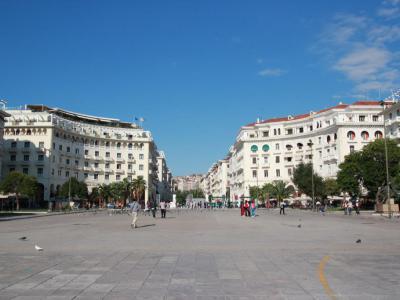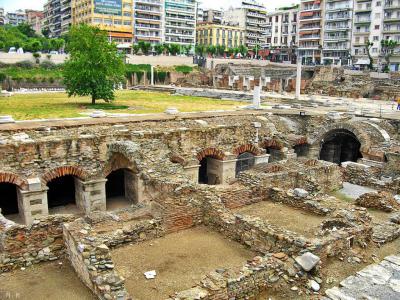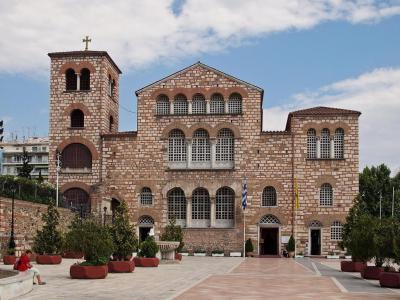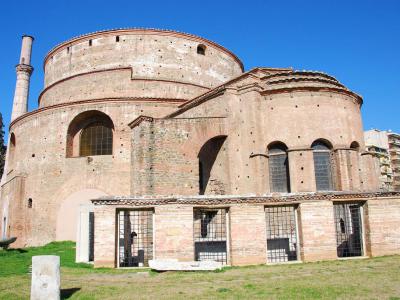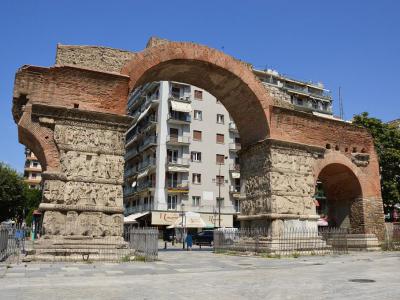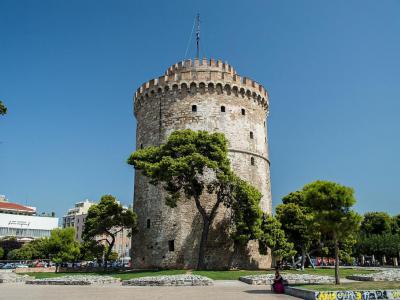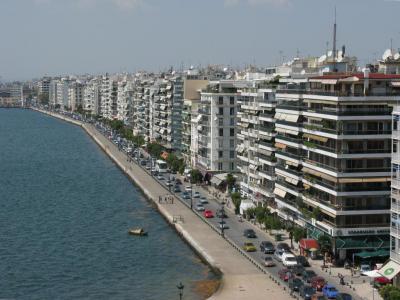Thessaloniki Introduction Walking Tour (Self Guided), Thessaloniki
Thessaloniki is Greece's second-largest city as well as its second major political, industrial, commercial, and economic center.
Historically, Thessaloniki co-ruled the Byzantine Empire along with Constantinople. But its history goes back even further than that. Cassander of Macedon originally founded the city in 315 BC. Cassander named the city after his wife, Thessalonike. Thessalonike was Philip II of Macedon's daughter and Alexander the Great's half-sister.
Thessaloniki became Macedonia's most important city and had its own parliament until the Kingdom of Macedonia fell in 168 BC. Then, in 148 BC, Thessaloniki became Roman Macedonia's capital before becoming a Roman Republic free city in 41 BC.
Thessaloniki was one of Christianity's early centers. The Apostle Paul visited the city's main synagogue, and his visits inspired leaders to found a Christian church. Paul's letters to Thessaloniki are recorded in the Bible as First and Second Thessalonians.
Saint Demetrius was killed by Roman soldiers in 306 AD and later became the city's patron saint. The Church of St. Demetrios was built in the fifth century AD on the spot where Demetrios was killed and still stands today.
The Romans built the Rotunda and Arch of Galerius in the early fourth century. After the fall of the Roman Empire, Thessaloniki became the Byzantine Empire's second most important city.
Thessaloniki fell to the Fourth Crusade in 1204 and went through a period of unrest and changing governments until the Ottomans captured the city in 1430. The Turks ruled the city for nearly five centuries. Finally, Greece liberated the city in 1912.
Thessaloniki features many stunning landmarks. Visitors can see many fine examples of Byzantine architecture, Roman ruins, and Ottoman Empire structures.
Thessaloniki is one of the area's most popular destinations, and National Geographic Magazine once named Thessaloniki one of the world's top tourist must-sees.
Many ancient landmarks are listed as UNESCO World Heritage Sites. In addition, Thessaloniki hosts many cultural festivals, including the Thessaloniki International Film Festival and the Thessaloniki International Fair.
Thessaloniki is an attractive waterfront city located on the Thermaic Gulf, part of the Aegean Sea. Take this self-guided tour to explore Thessaloniki's impressive history and culture.
Historically, Thessaloniki co-ruled the Byzantine Empire along with Constantinople. But its history goes back even further than that. Cassander of Macedon originally founded the city in 315 BC. Cassander named the city after his wife, Thessalonike. Thessalonike was Philip II of Macedon's daughter and Alexander the Great's half-sister.
Thessaloniki became Macedonia's most important city and had its own parliament until the Kingdom of Macedonia fell in 168 BC. Then, in 148 BC, Thessaloniki became Roman Macedonia's capital before becoming a Roman Republic free city in 41 BC.
Thessaloniki was one of Christianity's early centers. The Apostle Paul visited the city's main synagogue, and his visits inspired leaders to found a Christian church. Paul's letters to Thessaloniki are recorded in the Bible as First and Second Thessalonians.
Saint Demetrius was killed by Roman soldiers in 306 AD and later became the city's patron saint. The Church of St. Demetrios was built in the fifth century AD on the spot where Demetrios was killed and still stands today.
The Romans built the Rotunda and Arch of Galerius in the early fourth century. After the fall of the Roman Empire, Thessaloniki became the Byzantine Empire's second most important city.
Thessaloniki fell to the Fourth Crusade in 1204 and went through a period of unrest and changing governments until the Ottomans captured the city in 1430. The Turks ruled the city for nearly five centuries. Finally, Greece liberated the city in 1912.
Thessaloniki features many stunning landmarks. Visitors can see many fine examples of Byzantine architecture, Roman ruins, and Ottoman Empire structures.
Thessaloniki is one of the area's most popular destinations, and National Geographic Magazine once named Thessaloniki one of the world's top tourist must-sees.
Many ancient landmarks are listed as UNESCO World Heritage Sites. In addition, Thessaloniki hosts many cultural festivals, including the Thessaloniki International Film Festival and the Thessaloniki International Fair.
Thessaloniki is an attractive waterfront city located on the Thermaic Gulf, part of the Aegean Sea. Take this self-guided tour to explore Thessaloniki's impressive history and culture.
How it works: Download the app "GPSmyCity: Walks in 1K+ Cities" from Apple App Store or Google Play Store to your mobile phone or tablet. The app turns your mobile device into a personal tour guide and its built-in GPS navigation functions guide you from one tour stop to next. The app works offline, so no data plan is needed when traveling abroad.
Thessaloniki Introduction Walking Tour Map
Guide Name: Thessaloniki Introduction Walking Tour
Guide Location: Greece » Thessaloniki (See other walking tours in Thessaloniki)
Guide Type: Self-guided Walking Tour (Sightseeing)
# of Attractions: 8
Tour Duration: 2 Hour(s)
Travel Distance: 3.7 Km or 2.3 Miles
Author: vickyc
Sight(s) Featured in This Guide:
Guide Location: Greece » Thessaloniki (See other walking tours in Thessaloniki)
Guide Type: Self-guided Walking Tour (Sightseeing)
# of Attractions: 8
Tour Duration: 2 Hour(s)
Travel Distance: 3.7 Km or 2.3 Miles
Author: vickyc
Sight(s) Featured in This Guide:
- Aristotelous Square
- Church of Hagia Sophia
- Greek Agora and Roman Forum
- Hagios Demetrios (Church of St. Demetrios)
- Rotunda of Galerius
- Arch of Galerius
- White Tower of Thessaloniki
- Leoforos Nikis/Nikis (Victory) Avenue
1) Aristotelous Square (must see)
It was August, 1917. Greece had taken the Allied side in the Great War and the city of Thessaloniki was teeming with British and French troops and refugees from Turkey. In a small house of refugees at OLympiados 3, an ember from the kitchen fire set some straw alight. The fire spread, driven by the wind, and Thessaloniki burned for two days.
French architect Ernest Hebrard was in town. Prime Minister Eleftherios Venizelos forbade any reconstruction without a modern plan and he commissioned Hebrard for the job.
Hebrard came up with a city-wide plan of large squares and broad avenues and buildings with imposing facades derived from Byzantine elements. Among the large squares was Alexander the Great Square, now called Aristotelous Square.
A monumental axis stretches from sea-facing Aristotelous Square to Dikastirion Square and the Roman Forum. Looking uphill from the square one can see the ancient Byzantine walls of the city. A statue of Alexander the Great rides the waterfront esplanade of the square. Eleftherios Venizelos raises his right hand in benediction.
Aristotle relaxes in his chiton and sandals. The big toe of his left foot shines from rubbings of students hoping his wisdom will rub off. The square is a venue for rallies and demonstrations and cultural events, including annual Christmas and carnival celebrations.
The square is also home to several landmark buildings, such as the Electra Palace Hotel. This iconic hotel features stunning architecture and lavish interior decorations. In addition, visitors can check out the Orizontes Roof Garden and enjoy a spectacular waterfront view while dining or enjoying a cocktail.
The Olympion Theatre Cinema is another popular attraction. The neoclassical Olympion hosts the annual International Film Festival of Thessalonica. This film festival began in 1960 and facilities film viewers to discuss the chosen movies with film directors.
French architect Ernest Hebrard was in town. Prime Minister Eleftherios Venizelos forbade any reconstruction without a modern plan and he commissioned Hebrard for the job.
Hebrard came up with a city-wide plan of large squares and broad avenues and buildings with imposing facades derived from Byzantine elements. Among the large squares was Alexander the Great Square, now called Aristotelous Square.
A monumental axis stretches from sea-facing Aristotelous Square to Dikastirion Square and the Roman Forum. Looking uphill from the square one can see the ancient Byzantine walls of the city. A statue of Alexander the Great rides the waterfront esplanade of the square. Eleftherios Venizelos raises his right hand in benediction.
Aristotle relaxes in his chiton and sandals. The big toe of his left foot shines from rubbings of students hoping his wisdom will rub off. The square is a venue for rallies and demonstrations and cultural events, including annual Christmas and carnival celebrations.
The square is also home to several landmark buildings, such as the Electra Palace Hotel. This iconic hotel features stunning architecture and lavish interior decorations. In addition, visitors can check out the Orizontes Roof Garden and enjoy a spectacular waterfront view while dining or enjoying a cocktail.
The Olympion Theatre Cinema is another popular attraction. The neoclassical Olympion hosts the annual International Film Festival of Thessalonica. This film festival began in 1960 and facilities film viewers to discuss the chosen movies with film directors.
2) Church of Hagia Sophia (must see)
Hagia Sophia means "Holy Wisdom". The Church of Hagia Sophia is listed as a UNESCO World Heritage Site and is one of Thessaloniki's most striking and iconic landmarks.
A church has been located on the site since the third century. The current church was built in the seventh century and emulated Istanbul's Hagia Sophia.
The Church of Hagia Sophia features a domed Greek cross basilica floor plan and is one of the main examples of this architectural style.
The gold mosaic in the dome depicts the Ascension and is surrounded by the Twelve Apostles, Mary, and two angels.
The Hagia Sophia was converted to the cathedral of Thessaloniki in 1205 during the Fourth Crusade. From 1205 to 1224, the Hagia Sophia was used as a Catholic church.
In 1430, the Ottoman Empire captured Thessaloniki and turned the Church of Hagia Sophia into a mosque in 1524. The mosque was called Ayia Sofia. In order to complete its transformation into a mosque, workers added an arched portico, a minaret, and a tower. When Thessaloniki was liberated in 1912, the church was finally reconverted to a Christian church.
The porch and minaret were removed, but the tower's base remains.
The church was damaged in the 1917 fire and wasn't restored until 1980. The interior features beautiful mosaics and stunning frescoes. Most of the frescoes date from the 11th century.
The dome features a spectacular 9th-century mosaic that shows Christ's Ascension. Capitals on the interior columns date to the fifth century and were likely originally in the previous church. The columns have a deep relief and dramatic carvings.
A church has been located on the site since the third century. The current church was built in the seventh century and emulated Istanbul's Hagia Sophia.
The Church of Hagia Sophia features a domed Greek cross basilica floor plan and is one of the main examples of this architectural style.
The gold mosaic in the dome depicts the Ascension and is surrounded by the Twelve Apostles, Mary, and two angels.
The Hagia Sophia was converted to the cathedral of Thessaloniki in 1205 during the Fourth Crusade. From 1205 to 1224, the Hagia Sophia was used as a Catholic church.
In 1430, the Ottoman Empire captured Thessaloniki and turned the Church of Hagia Sophia into a mosque in 1524. The mosque was called Ayia Sofia. In order to complete its transformation into a mosque, workers added an arched portico, a minaret, and a tower. When Thessaloniki was liberated in 1912, the church was finally reconverted to a Christian church.
The porch and minaret were removed, but the tower's base remains.
The church was damaged in the 1917 fire and wasn't restored until 1980. The interior features beautiful mosaics and stunning frescoes. Most of the frescoes date from the 11th century.
The dome features a spectacular 9th-century mosaic that shows Christ's Ascension. Capitals on the interior columns date to the fifth century and were likely originally in the previous church. The columns have a deep relief and dramatic carvings.
3) Greek Agora and Roman Forum
The Roman Forum is an excavated Roman-era forum, also known as the "Ancient Agora." In 1966, workmen, while digging the foundations for the new Thessaloniki Municipal Courthouse, uncovered the remains of the agora. The Municipal Courthouse was moved to another location and archeologists excavated the area.
When the Romans came to Thessaloniki they enlarged the Greek agora and created a forum on two levels. The complex features two Roman baths and a theater used for gladiator games. The original Roman forum was built in the second century and used through the sixth century. It was the religious, administrative, and social center of the city. The forum was connected to the city's main streets.
The Roman Forum was decorated with ornate arches, fountains, and cloisters. Visitors can see the restored amphitheater inside the agora. Parts of ancient Corinthia columns are still standing. These columns formed two-story porticoes. The forum also had beautiful mosaic floors.
The Cryptoporticus semi-subterranean corridors are very well preserved. Visitors can follow this corridor to the forum's underground museum. The museum includes exhibits with artifacts from the site, including silver coins and marble sculptures.
When the Romans came to Thessaloniki they enlarged the Greek agora and created a forum on two levels. The complex features two Roman baths and a theater used for gladiator games. The original Roman forum was built in the second century and used through the sixth century. It was the religious, administrative, and social center of the city. The forum was connected to the city's main streets.
The Roman Forum was decorated with ornate arches, fountains, and cloisters. Visitors can see the restored amphitheater inside the agora. Parts of ancient Corinthia columns are still standing. These columns formed two-story porticoes. The forum also had beautiful mosaic floors.
The Cryptoporticus semi-subterranean corridors are very well preserved. Visitors can follow this corridor to the forum's underground museum. The museum includes exhibits with artifacts from the site, including silver coins and marble sculptures.
4) Hagios Demetrios (Church of St. Demetrios) (must see)
Church of Saint Demetrios is a Paleochristian and Byzantine Monument of Thessaloniki. It is listed as a UNESCO World Heritage Site since 1988.
Demetrios was born in 270 AD. He rose to a high rank in the Roman army and secretly converted many Romans to the Christian faith. Emperor Galerius Maximianus, persecutor of Christians, had Demetrios killed and his body dumped into a bath house. Demetrios is referred as a military saint. He is credited with guarding the city through its many sieges.
A church was built over the bath house where Demetrios was killed. The prefect of Illyricum later replaced the church with a three aisled basilica. In the 7th century the basilica was rebuilt after a fire. The rebuilt basilica had five aisles and took the form it retains today.
After the Great Fire of 1917 the Church of Hagios Demetrios was a charred ruin. Restoration began in 1925. Bricks as well as tombstones from the Jewish Cemetery were used. In the fire of 1917, 30 synagogues were destroyed.
Only nine mosaics from the 5th through the 9th centuries survived the fire. They depict children making offerings to the saint, the saint with priests, and the saint with patrons of the church. The mosaics are mostly on the west wall of the nave.
The columns of the central nave vary in height and color. The variation in height is compensated for by adjustment of the bases. The motifs of the capitals involve Theodosian capitals, doves, rams, eagles and acanthus leaves.
The crypt is below the altar. It functions as a museum and contains artifacts excavated from ruins of the fire.
Demetrios was born in 270 AD. He rose to a high rank in the Roman army and secretly converted many Romans to the Christian faith. Emperor Galerius Maximianus, persecutor of Christians, had Demetrios killed and his body dumped into a bath house. Demetrios is referred as a military saint. He is credited with guarding the city through its many sieges.
A church was built over the bath house where Demetrios was killed. The prefect of Illyricum later replaced the church with a three aisled basilica. In the 7th century the basilica was rebuilt after a fire. The rebuilt basilica had five aisles and took the form it retains today.
After the Great Fire of 1917 the Church of Hagios Demetrios was a charred ruin. Restoration began in 1925. Bricks as well as tombstones from the Jewish Cemetery were used. In the fire of 1917, 30 synagogues were destroyed.
Only nine mosaics from the 5th through the 9th centuries survived the fire. They depict children making offerings to the saint, the saint with priests, and the saint with patrons of the church. The mosaics are mostly on the west wall of the nave.
The columns of the central nave vary in height and color. The variation in height is compensated for by adjustment of the bases. The motifs of the capitals involve Theodosian capitals, doves, rams, eagles and acanthus leaves.
The crypt is below the altar. It functions as a museum and contains artifacts excavated from ruins of the fire.
5) Rotunda of Galerius (must see)
The Rotunda of Galerius is an impressive cylindrical structure. Roman co-emperor Galerius built the Rotunda in 306 AD. Some historians believe that Galerius intended the structure to be a mausoleum, while others believe it was a temple.
The Rotunda's walls are over six meters (18 feet) thick and have helped the Rotunda survive earthquakes. The building is over 29 meters (95 feet) tall and 24.5 meters (80 feet) in diameter.
The Rotunda is architecturally similar to the famous Pantheon in Rome.
A road links the Rotunda to the Arch of Galerius. The Rotunda served as a Christian church during the Byzantine Empire era when an additional sanctuary was added to the building.
The interior features mosaics dating to the Early Byzantine period. The Rotunda served as Thessaloniki's cathedral from 1524 to 1591. In 1591, it was converted to a mosque when the Ottoman Empire invaded. The Rotunda served as a mosque until the city's liberation in 1912. After the liberation, the church was dedicated to Saint George.
Visitors will be delighted by the myriad of exceptional mosaics. The mosaics in the barrel vaults feature natural scenes such as birds, flowers, and fruit baskets. The southern niche's mosaic features a gold Latin Cross surrounded by birds, stars, flowers, and fruits.
Earthquakes have damaged the dome's mosaics throughout the centuries. The "martyrs frieze" features mosaics of several saints.
A mosaic medallion is located in the apex of the dome. This mosaic shows angels holding a medallion. Unfortunately, the depiction of a young Christ holding a cross has been heavily damaged.
The semidome of the apse features a painting of the Ascension.
When the Rotunda was converted into a mosque in 1591, a minaret was added. The minaret is one of the few still standing at full height.
The Rotunda's walls are over six meters (18 feet) thick and have helped the Rotunda survive earthquakes. The building is over 29 meters (95 feet) tall and 24.5 meters (80 feet) in diameter.
The Rotunda is architecturally similar to the famous Pantheon in Rome.
A road links the Rotunda to the Arch of Galerius. The Rotunda served as a Christian church during the Byzantine Empire era when an additional sanctuary was added to the building.
The interior features mosaics dating to the Early Byzantine period. The Rotunda served as Thessaloniki's cathedral from 1524 to 1591. In 1591, it was converted to a mosque when the Ottoman Empire invaded. The Rotunda served as a mosque until the city's liberation in 1912. After the liberation, the church was dedicated to Saint George.
Visitors will be delighted by the myriad of exceptional mosaics. The mosaics in the barrel vaults feature natural scenes such as birds, flowers, and fruit baskets. The southern niche's mosaic features a gold Latin Cross surrounded by birds, stars, flowers, and fruits.
Earthquakes have damaged the dome's mosaics throughout the centuries. The "martyrs frieze" features mosaics of several saints.
A mosaic medallion is located in the apex of the dome. This mosaic shows angels holding a medallion. Unfortunately, the depiction of a young Christ holding a cross has been heavily damaged.
The semidome of the apse features a painting of the Ascension.
When the Rotunda was converted into a mosque in 1591, a minaret was added. The minaret is one of the few still standing at full height.
6) Arch of Galerius (must see)
The Arch of Galerius was dedicated in 303 AD to celebrate Roman co-emperor Galerius' victory against the Persians. The structure originally featured an eight-pillared gateway that formed a triple arch. A road connected the Arch with the Rotunda and the Palace complex.
Today, only three of the eight pillars survive. However, the Arch of Galerius is still one of Thessaloniki's most distinctive landmarks. Locals know it as Kamara and often use the landmark as a meeting point.
The two central pillars feature sculpted marble slabs, depicting Galerius fighting the Persians. Another marble relief shows the imperial family making a thanksgiving sacrifice. Unfortunately, all faces have been chiseled off the reliefs. This damage was possibly done to commemorate the dead.
Another panel shows the unity of the tetrarchy, with Galerius dressed in armor. The Arch of Galerius is on the UNESCO World Heritage List.
Today, only three of the eight pillars survive. However, the Arch of Galerius is still one of Thessaloniki's most distinctive landmarks. Locals know it as Kamara and often use the landmark as a meeting point.
The two central pillars feature sculpted marble slabs, depicting Galerius fighting the Persians. Another marble relief shows the imperial family making a thanksgiving sacrifice. Unfortunately, all faces have been chiseled off the reliefs. This damage was possibly done to commemorate the dead.
Another panel shows the unity of the tetrarchy, with Galerius dressed in armor. The Arch of Galerius is on the UNESCO World Heritage List.
7) White Tower of Thessaloniki (must see)
The 23 meters (75 feet) tall White Tower is known as the symbol of Thessaloniki. The Ottomans built the tower around 15th century. It is thought that the fortress was designed by the famous Ottoman architect Mirmar Sinan. It was originally surrounded by fortified walls and was an essential part of Thessaloniki's defenses.
When it was first constructed, it was known as the Lion Tower to honor the Ottoman's victory. The tower was part of the old city's walls and separated the Jewish quarter from the Muslim quarter.
It was renamed the Tower of Kalamaria in the 17th century. It was then used as a garrison. Next, the tower was used as a prison and became known as the Tower of Blood or the Red Tower. During this time, the tower was the site of torture and execution. For example, in 1826, Sultan Mahmud II ordered the massacre of the rebellious Janissaries imprisoned in the tower.
Finally, the tower was painted white in 1891 and named the White Tower. Some historians suggest that the Ottoman Empire sought to "whitewash" the tower's brutal torture history with a change of paint and a new name. While the truth behind the change is unknown, the White Tower name has stuck.
King George I of Greece was assassinated near the White Tower in 1913. Hopefully this was the last drop of blood for the White Tower.
The tower served as an Allied forces communication center during World War I. At this time, the defensive walls were taken down. The White Tower also protected priceless antiquities during World War I.
Thessaloniki's air defense operated from the tower from 1912 to 1983. The tower also housed a meteorological laboratory.
Visitors can enjoy expansive views of the city and Thermaic Gulf from the top floor. In addition, the promenade in front of the tower is a popular spot for photos and meetings.
The White Tower is home to a museum that celebrates Thessaloniki's history. Exhibitions explore the city's history from its founding in 316 BC to today.
When it was first constructed, it was known as the Lion Tower to honor the Ottoman's victory. The tower was part of the old city's walls and separated the Jewish quarter from the Muslim quarter.
It was renamed the Tower of Kalamaria in the 17th century. It was then used as a garrison. Next, the tower was used as a prison and became known as the Tower of Blood or the Red Tower. During this time, the tower was the site of torture and execution. For example, in 1826, Sultan Mahmud II ordered the massacre of the rebellious Janissaries imprisoned in the tower.
Finally, the tower was painted white in 1891 and named the White Tower. Some historians suggest that the Ottoman Empire sought to "whitewash" the tower's brutal torture history with a change of paint and a new name. While the truth behind the change is unknown, the White Tower name has stuck.
King George I of Greece was assassinated near the White Tower in 1913. Hopefully this was the last drop of blood for the White Tower.
The tower served as an Allied forces communication center during World War I. At this time, the defensive walls were taken down. The White Tower also protected priceless antiquities during World War I.
Thessaloniki's air defense operated from the tower from 1912 to 1983. The tower also housed a meteorological laboratory.
Visitors can enjoy expansive views of the city and Thermaic Gulf from the top floor. In addition, the promenade in front of the tower is a popular spot for photos and meetings.
The White Tower is home to a museum that celebrates Thessaloniki's history. Exhibitions explore the city's history from its founding in 316 BC to today.
8) Leoforos Nikis/Nikis (Victory) Avenue
Victory Avenue (Leoforos Nikis) stands out as the most renowned and bustling shopping street in the heart of Thessaloniki. It's a place that's constantly captured in photographs and paintings, and it boasts the highest property prices in the city. This three-line central street, also known as Old Waterfront, runs from Eleftherias Square and the Port, all the way along the coast, past Aristotelous Square, towards the White Tower and Alexander the Great Avenue.
As a prestigious location, Victory/Nikis Avenue is home to some of the most luxurious residences and commercial spaces in the city, as well as hosting several foreign consulates. It's a hub for commerce and entertainment, housing the finest nightclubs, numerous bars, restaurants, and retail stores that attract both tourists and locals alike. Throughout its history, it has been the site of iconic cafes, patisseries, historic cinemas, and luxury hotels along the seafront.
Originally known by different names like "Beyaz Kule Avenue" during Ottoman rule and "Vasileos Konstantinou Avenue" until 1939, it was finally named "Nikis Avenue" in 1939 to commemorate the victory in the Balkan Wars of 1912-13. The wide pedestrian sidewalk along the waterfront remains a popular spot for visitors and locals to enjoy strolls while taking in the breathtaking sea views.
As a prestigious location, Victory/Nikis Avenue is home to some of the most luxurious residences and commercial spaces in the city, as well as hosting several foreign consulates. It's a hub for commerce and entertainment, housing the finest nightclubs, numerous bars, restaurants, and retail stores that attract both tourists and locals alike. Throughout its history, it has been the site of iconic cafes, patisseries, historic cinemas, and luxury hotels along the seafront.
Originally known by different names like "Beyaz Kule Avenue" during Ottoman rule and "Vasileos Konstantinou Avenue" until 1939, it was finally named "Nikis Avenue" in 1939 to commemorate the victory in the Balkan Wars of 1912-13. The wide pedestrian sidewalk along the waterfront remains a popular spot for visitors and locals to enjoy strolls while taking in the breathtaking sea views.
Walking Tours in Thessaloniki, Greece
Create Your Own Walk in Thessaloniki
Creating your own self-guided walk in Thessaloniki is easy and fun. Choose the city attractions that you want to see and a walk route map will be created just for you. You can even set your hotel as the start point of the walk.
Thessaloniki Upper Town Walking Tour
Thessaloniki's Upper Town (Ano Poli) is the most ancient part of the city, aged approximately 2,300 years. Being also the highest part of Thessaloniki, dominated by the Acropolis with the Byzantine-/Ottoman-era fort known as Heptapyrgion (Eptapyrgio), from here on a clear day you can see way across the gulf, as far as Mount Olympus, some 80 km (50 miles) away, towering over the horizon in all... view more
Tour Duration: 2 Hour(s)
Travel Distance: 4.0 Km or 2.5 Miles
Tour Duration: 2 Hour(s)
Travel Distance: 4.0 Km or 2.5 Miles
Thessaloniki Waterfront Tour
The Mediterranean has always been an integral part of Thessaloniki’s appeal. The city's orientation toward the sea is largely due to the vision of Ernest Hébrard, the French urban planner and architect, who redesigned the downtown area after the devastating fire of 1917.
To really get the taste of Thessaloniki you need to visit not just its historical landmarks, but also those spots... view more
Tour Duration: 1 Hour(s)
Travel Distance: 2.6 Km or 1.6 Miles
To really get the taste of Thessaloniki you need to visit not just its historical landmarks, but also those spots... view more
Tour Duration: 1 Hour(s)
Travel Distance: 2.6 Km or 1.6 Miles
The Most Popular Cities
/ view all



